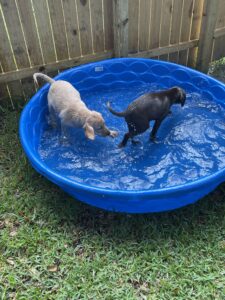Socialization Tips: How to Socialize Your Labrador with Other Dogs and People
Welcome to the beautiful world of Labrador socialization, where wagging tails and friendly barks are just the beginning! Whether you're a new Lab parent or looking to brush up on your furry friend's social skills, this guide from Borosky Labradors is your go-to for turning your lovable Lab into the most friendly pup on the block. From mastering the art of puppy playdates to navigating the nuances of doggy communication, we have all the tips and tricks to help your Labrador make friends with four-legged pals and two-legged companions. Let's embark on this exciting journey to a well-rounded, happy, and friendly Labrador!
Puppy Playdates: The Key to Canine Friendships.

Imagine you're a Labrador. The world is an enchanting playground filled with intriguing smells, exciting sounds, and, most importantly, opportunities to meet other dogs and people! The first step to transforming your Lab into the social superstar of the neighborhood is engaging in puppy playdates. It's like kids hanging out after school; Labs thrive on these interactions. You can begin with one-on-one meetings in a secure, enclosed area where your pup can safely explore and socialize. As your Lab mingles, observe their joy and eagerness, their tail wagging a rhythmic beat of happiness. These playdates are more than just fun; they're essential in teaching your Lab the canine code of conduct—understanding gestures, play signals, and respectful boundaries. This foundational step is crucial, laying the groundwork for their future interactions, ensuring they grow into well-adjusted, friendly adults who confidently say "hello" and "let's play" in the universal language of wagging tails and playful barks.
Barking Up the Right Tree: Effective Communication Skills
In the canine world, communication extends far beyond barking or tail wagging; it's an intricate dance of gestures and expressions, forming a language your Lab must master to excel socially. When two dogs meet, it's like watching a silent conversation unfold, where every movement has meaning. A relaxed posture, playful bow, or gentle tail wag signals all is well, inviting friendship and play. In contrast, growling, bared teeth, or stiffening are clear signs of discomfort or warning. Teaching your Lab to interpret and respond to these cues is crucial. It's akin to teaching a child to understand emotions and react appropriately—recognizing a friend's smile or sensing when someone needs space. This understanding of canine etiquette prevents misunderstandings and builds a foundation of trust and respect among furry peers. Moreover, it enhances your connection with your Lab as you learn to read their signals and understand their emotions, strengthening your bond with your four-legged companion.
The Leash on Learning: Training Your Lab for Social Interactions.

Delving into training, it's vital to recognize that educating your Lab goes beyond the basics of 'sit' and 'stay.' It's about instilling good manners and appropriate behavior in various social situations. This training involves a blend of rewards and gentle guidance. Use treats and praise to reinforce positive interactions, such as calmly approaching another dog or politely greeting someone. If your Lab becomes overly excited or shows signs of fear, it's essential to pause and reset. Think of this as a playful time-out, akin to pressing the pause button during an intense game, allowing you and your Lab to regroup and approach the situation with renewed focus and calmness. Additionally, incorporating games and activities that promote impulse control and patience can be highly beneficial. These exercises make learning enjoyable and equip your Lab with the skills to navigate social encounters gracefully, ensuring they're both confident and courteous in their interactions with others. Now, let's talk about training. Training your Lab isn't just about 'sit' and 'stay.' It's about teaching them how to behave around others. Use treats and praises to encourage friendly behavior. If your Lab gets too excited or scared, it's time for a little break. Think of it like a time-out but in a fun way. It's like when you're playing a game and need to breathe to return stronger!
Sniffing Out Success: Socialization Tips for Various Settings
Social savvy for your Lab extends beyond the confines of the dog park; it's about cultivating grace and good manners in various environments. Each setting presents its unique social rules and challenges. On leisurely walks, for instance, it's essential to teach your Lab the art of composure and maintaining calmness when encountering other dogs or people. This can involve practicing focused walking techniques and calming signals to manage excitement or anxiety. At the veterinarian's office, patience is vital. Transform potentially stressful waits into opportunities for calm sitting or gentle interactions with staff. When welcoming guests into your home, your Lab can showcase its charm by greeting visitors with gentle curiosity rather than overzealous affection. Introducing simple commands like 'sit to greet' can make these interactions enjoyable for both your guests and your pet. Additionally, incorporating varied scenarios in your Lab's training regimen can significantly boost their adaptability, ensuring they're well-equipped to handle diverse social situations with poise and confidence. This holistic approach to socialization enhances your Lab's quality of life and solidifies its reputation as a well-mannered and delightful companion in any setting.
Happy Tails: Ensuring Positive Experiences for Your Lab and Others
Achieving happy tails is about creating joyful and positive experiences for your Lab and everyone they meet. Monitoring each interaction closely is essential, ensuring it remains pleasant and stress-free. If your Lab shows signs of fear or aggression, it's a cue to slow down and adopt a more gentle, patient approach. Remember, socialization is a journey, not a race. It's similar to learning a new skill, where gradual progress and positive reinforcement are critical. Shower your Lab with affection and patience, celebrating small victories. Introducing diverse and controlled social scenarios helps build their confidence. You can encourage interactions with various people and dogs, always within the comfort zone of your Lab. This careful nurturing will help your Lab blossom into a well-adjusted, friendly canine, adept at making friends in both the dog and human worlds. The ultimate goal is a happy, tail-wagging Lab who is a joy to be around and spreads happiness wherever they go.
Remember, socializing your Labrador is a journey full of fun, treats, and tail wags. It's about helping them discover the world safely and happily. So grab that leash and some treats, and let the adventure begin!
Article by Paul Borosky, MBA, Doctoral Candidate, Author, and Owner of Borosky Labradors (using AI)
Date: 12/27/23